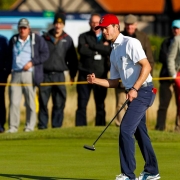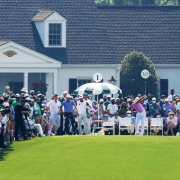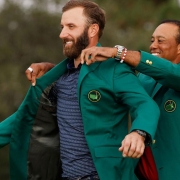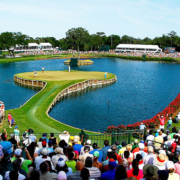Charity Golf In Town
If you’ve played any golf in North Florida you’ve probably played in a charity golf tournament. Big or small, golf tournaments raising money for charity are among the biggest fundraising sources for charities in our part of the country.
“Before Covid, we held as many as twenty fund-raising events every year,” Chet Stokes, General Manager at Marsh Landing Country Club in Ponte Vedra revealed. “We want to be a part of the community and give back when we can. This is a way we can do that.”
Golf clubs have to strike a balance between maintenance, member play and supporting charitable initiatives.
“Typically, the club industry is a key player in helping charities throughout the state of Florida,” Leon Crimmins the former President of the Florida Club Managers Association of America explained.
There are some big charity tournaments, like Tom Coughlin’s Jay Fund event at the TPC at Sawgrass that’s been around since 1996, and there are some small ones, like the one my friend Frank Hughes started last year on Amelia Island to benefit the local Set Free By The Sea ministry.
“We know people like to play golf and we have some great golf courses, so it just made sense,” Hughes explained. “It doesn’t have to cost a lot of money to get people together, share some fellowship and have some fun. We raised a little money but more importantly we raised a lot of awareness of who we are.”
Last weekend I was invited again to play in the Funk-Zitiello, Champions for Hope golf tournament at the TPC Stadium Course. It includes a banquet Friday night and golf Saturday morning. In the past forty years, I’ve probably played in close to a thousand charity golf tournaments, but few have rivaled the Champions for Hope.
They raise a bunch of money; they create great fellowship and awareness, but it feels like nothing but pure fun while you’re there.
There are plenty of ways to raise money, but Champions for Hope picked a golf tournament. And not by accident.
“I thought about throwing an Italian wedding feast and making it a charity event,” Tommy Zitiello, the tournament’s founder explained this week. “Who doesn’t have a good time at an Italian wedding?”
They started out raising money for the J.T. Townsend Foundation with a few parties but then Zitiello’s wife Judy was diagnosed with pancreatic cancer seven years ago
Zitiello, affectionately known as ‘Tommy Z’ wasn’t sure which way to turn. The survival rate for pancreatic cancer is the lowest among all cancers. Just around nine percent.
“I thought, everything we built together was gone,” Tommy added quietly. “I listened to all of the statistics about beating cancer and the research dollars needed and found that the survival rate for about every other cancer had grown by fifty per cent or more. Except this one.”
Zitiello decided to ‘go big’ and started a golf tournament to raise money for both the JT Townsend Foundation and for research into early detection for pancreatic cancer. It was an ambitious effort, but Tommy believes through faith, he was able to create something special.
“I made my money in sales,” he explained. “My only talent was speaking and selling. And I’m convinced that I made money because God knew I was going to give it back.”
Champions for Hope has raised millions of dollars in its five years, including $700,000 this year coming out of the pandemic. They’ve helped 672 families here in Jacksonville who have adaptive equipment needs. Judy has beaten the odds and is a seven-year cancer survivor.
“You can’t just sit back, you have to get involved,” Tommy added. “It’s grass roots, friends and family and every bodies fully invested. Not one person makes a nickel working at our event. Our CPA, lawyers, our restaurants, our liquor, our family, all of our volunteers, they’re there for nothing. If you’re not working at it and taking your time, it’s not really charity.”
I heard that over and over this week. Giving, of time and money on a grass roots level here in town, is the key.
“Champions for Hope is the message,” he concluded. “A doctor once told me ‘When you give someone love you give them hope.’ Giving people hope is the message.”
While Tommy’s tournament is one of the best I’ve ever played in, the first “Back to Camp” tournament is the craziest.
In the mid-80’s it was popular to bring former professional athletes to town to play and entertain, as well as entice fans to plunk down some money to play with their now-retired heroes. It followed the Miller Lite and the Bud Light promotions at the time, celebrating how much fun it would be to hang out with retired ballplayers.
That first year was a rousing success in the fun category, especially when one player was found asleep under a bench in the locker room, and another was able to make his plane heading out of town by leaving his rental car on the curb at arrivals at JIA. Running.
Because of the expense of bringing the former players to town and putting them up for three nights, the tournament didn’t raise much money, but it did bring the charity a lot of notoriety.
“We’re trying to get the message out,” Tommy Z added about the Champions for Hope golf event. “I see new people each year at our tournament who heard about it from a friend. We just need to get lucky with a big philanthropist or a big corporation to help get to the next level.”
For twenty-five years I was honored and flattered to have my name on charity golf tournaments here in town raising nearly $10 Million. The first was to raise money for housing downtown and then to help kids in life-threatening medical situations have a little fun.
“We went from not having a golf tournament to it being our number one fundraiser,” one of the chief administrators of the charity told me after we got started. “It’s such a natural here and with the generosity of people donating things to us, we’re able to put that money directly to benefit the kids.”
Yes, generosity. That’s a hallmark of what happens here in the golf community and the people and companies who get involved.
Whether you’re asking for a restaurant to donate lunch or a big golf retailer to provide some ‘hole prizes’ the answer is almost never ‘no.’ And they get hit up every week.
“The donation of the club’s facilities is what drives charity’s ability to raise significant funds,” Crimmins added, noting how most clubs help out. “Some clubs donate the golf course and charge for food and beverage at cost and absorb the cost of brining the staff in on a Monday. Different clubs do it different ways.”
There were over one-hundred twenty-five charity golf tournaments held every year in North Florida in the late nineties. That grew to over three hundred in the next ten years, following the golf boom. While that number has settled somewhat, all of those tournaments need prizes and oftentimes the golf courses themselves are helping out.
“Every week we get asked a few times to provide a four-some as a prize and we always say yes to that,” Stokes explained. “But we also try and play in tournaments around town to support the different causes. It’s important.”
Charity tournaments are not money-makers for local courses. The off-day revenue (most tournaments are played on Monday’s when courses are generally closed) comes from corporate outings.
“Clubs are very generous and charitable,” Crimmins added. “Club managers try to provide a balance of not sacrificing time for golf course maintenance while supporting charitable initiatives.”
And this doesn’t happen everywhere. I’ve got plenty of friends from around the country who are constantly amazed by the generosity and the money raised by golf tournaments here in North Florida. While the World Giving Index has listed the United States as the most generous country in the world for the last ten years, if there was a measure for golf giving, we’d rank near, if not at the top.
So, when you see one of those license plates that says “Florida, Golf Capital of the World,” which is debatable, add “Giving” to that phrase and smile, knowing that’s true.








